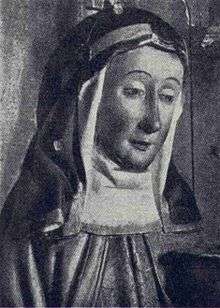Catherine of Vadstena
Catherine of Sweden, Katarina av Vadstena, Catherine of Vadstena or Katarina Ulfsdotter (c. 1332 – 24 March 1381) was a Swedish noblewoman. She is venerated as a saint in the Roman Catholic Church. Her father was Ulf Gudmarsson, Lord of Ulvåsa, and her mother was Bridget of Sweden (known as Birgitta Birgersdotter of Finsta in her lifetime).[2]
Saint Catherine of Sweden | |
|---|---|
 Saint Catherine in Trönö Old Church | |
| Born | 1331 or 1332[1] |
| Died | 24 March 1381 |
| Venerated in | Roman Catholic Church |
| Canonized | 1484 (cultus confirmed) by Innocent VIII |
| Feast | 24 March |
| Attributes | A hind at her side |
| Patronage | Women who suffer miscarriage |
Life
At the age of twelve or thirteen she married Lord Eggert van Kyren,[1] a religious young nobleman of German descent, whom she persuaded to take a vow of absolute chastity, and both lived in a state of virginity.[2] Catherine accompanied her mother to Rome in 1349 and soon upon arrival heard news of her husband's death. Catherine is said to have written a devotional work titled Consolation of the Soul (in medieval Swedish Siælinna tröst, or Själens tröst in modern Swedish); a dated copy from 1407 is still in existence.
She stayed on with her mother, accompanied her on several journeys, including one to the Holy Land. At the death of Bridget, Catherine returned to Sweden with her mother's body, which was buried at the monastery of Vadstena.[3] Catherine became head of the Brigittine convent at Vadstena Abbey, founded by her mother.[2] Catherine took on the task of forming the community in the rule her mother had written and directing the Order of the Holy Savior, or Bridgettines. Later, she returned to Rome to work for her mother's canonization. She stayed there five years and formed a close friendship with Catherine of Siena.[3]
Sainthood
In 1484, Pope Innocent VIII gave permission for Catherine's veneration as a saint and her feast was assigned to 22 March in the Roman Martyrology. Catherine is generally represented with a hind (female red deer) at her side, which is said to have come to her aid "when unchaste youths sought to ensnare her".[2]
In 1488, Pope Innocent VIII gave permission for the translation of her relics in Vadstena. The formal beatification and canonization process, which also documented the required miracles,[4] was never completed because of the Protestant Reformation.[5]
See also
References
- "Katarina av Vadstena". NationalEncyklopedin. Retrieved 21 February 2014. (in Swedish; subscription required)
-

- "St. Catherine of Vadstena". www.ewtn.com. Retrieved 29 April 2018.
- Beyer, Jürgen (1999). "On the Transformation of Apparition Stories in Scandinavia and Germany, c. 1350–1700". Folklore. Taylor & Francis Online. 110 (1–2): 39–47. doi:10.1080/0015587X.1999.9715979. Retrieved 21 February 2014. Fee required for full article.
- "Katarina Ulfsdotter". Nordisk Familjebok (1910). pp. 1281–1283. Retrieved on 21 February 2014. (in Swedish)